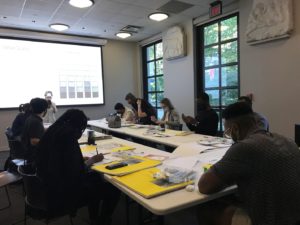Here we highlight five visual arts-based experiences taught by Emory clinical faculty and museum educators at the Carlos Museum of Art at Emory University and the High Museum of Art in Atlanta, Georgia.
Medical Humanities elective
Course description
The Emory School of Medicine Introduction to the Medical Humanities course was a unique on-line elective launched during the COVID-19 pandemic. This course uses a variety of media (art, film, literature, poetry) and humanities disciplines (history of medicine, ethics, anthropology, literature and medicine) to examine the role of the physician and the impact of disease on humanity and health. Students experienced the medical humanities as a way to enhance their observation skills, build teamwork, and promote a deeper understanding of their role as physicians-to-be. At the culmination of the four-week elective, each student created and shared their own work using either the visual or performance arts or creative writing.
Learning objectives
Students will:
- Explore the image of the doctor, the role of illness, and the social determinants of health from a variety of humanistic perspectives.
- Apply reflective writing tools to respond the physician’s role in health and disease over time
- Improve their observational abilities through close looking at works of art.
- Build verbal and interpersonal communication skills through observation, description, and analysis of works of film, narrative, and the visual arts.
Course images

I lost my gosh darn paddle
Oluwatoyin Thompson. April 16, 2020

Natalia Kuhn, April 16, 2020
Art of Palliation
Course information
- Course taught annually beginning in 2019.
- 3-6 session course to promote palliative care skills
- Interdisciplinary and interprofessional courses (MD, APP, RN, SW, M.Div, PhDs)
Course description
Practicing palliative care requires sustained compassion, self-reflection, and collaboration. Our challenge as interdisciplinary clinicians is to provide empathic and effective care to our patients and their families despite the daily barriers encountered in our healthcare systems. To address this challenge, we are offering a three-part art museum-based experiential curriculum designed to foster these core palliative care clinical and team-based skills outside of the usual structures and hierarchies of the healthcare environment. The first session focuses on self-awareness through critical observation and active listening skills. The second session explores bias, cultural humility, mortality and meaning. The third session addresses empathy and the tolerance of uncertainty. In each session, we reflect on these experiences relative to our practice in palliative care.
Paper highlighting museum-based education in hospice and palliative care, including coursework at Emory: Zarrabi, Ali John, et al. “Museum-Based Education: A Novel Educational Approach for Hospice and Palliative Medicine Training Programs.” Journal of palliative medicine 23.11 (2020): 1510-1514. (attached)
Course funding
- Emory School of Medicine Dean’s Imagine, Innovate, and Impact (I3) Education Award (2020-ongoing)
- Woodruff Health Sciences Center Interprofessional Education and Collaborative Practice (IPECP) Award (2019-2020)
- Emory Critical Care Center Burnout Mitigation Committee Grant (2018-2019)
Course images






Art of Pain
Course information
- Course taught annually beginning in 2020.
- 3 session course to promote skills in pain management
- Physician-only course comprised of pain fellows and faculty
Course description
Chronic pain and suffering are phenomena with physical, psychological, social, and spiritual dimensions. Pain is a multidimensional, fundamentally subjective condition, and its treatment is rooted in observation and interpretation. It is challenging to interpret the pain of others. Among the most challenging skills to teach or acquire as a clinician are experiential and collaborative approaches to caring for others, empathy, self-awareness, and self-care.
To address this challenge, we are offering a novel three-part art museum-based curriculum designed to foster core clinical competencies including close observation, reflective practice, metacognition, tolerance for ambiguity, and interprofessional and team communication. Chronic pain faculty and fellows will participate together, and the course will be taught by faculty and staff from Pain Management, Palliative Care, and the High Museum.
Course funding
- Emory School of Medicine Dean’s Imagine, Innovate, and Impact (I3) Education Award (2020-ongoing)
Course images


Art of Surgery and Medicine
Course Description
This medical school elective course focuses on the use of drawing and sketching will impact the development of hand and eye coordination, communication skills as well as observation skills can be enhanced as a health care provider. The focus is on those medical students interested in a career in surgery. The lectures are focused on how each skill is applied in the field of surgery. Through a series of five sessions beginning with contour drawing, gestures, shading, facial proportions, and the golden rule, ultimately to the focus of the human body in detail are brought into focus by developing their art techniques.
Course Objectives/ Outcomes
- Become comfortable using drawing and sketching as a communication tool.
- Increase observational skills. Learn to “see” through learning how to draw.
- Increase manual dexterity, hand to eye to brain coordination. Develop sense of touch.
- Identify Normal head and body proportions. Recognize anomalies.
- Learn about their own humanity through the study of objects of art through human history.
Course images




Joy in Practice
Course Description
A half-dozen Pediatric residents and faculty members gathered for a socially distanced event at the Carlos Museum. We spent the first hour getting to know one another, a process helped along by creating communal works of art. This was followed by a Visual Thinking Exercise using a collection of figures from the Art of the Americas Gallery. In the final hour, the group was then asked to enjoy the museum individually and to seek out a work of art that sparked joy when viewed. We re-convened and did a brief gallery tour together, discussing individual’s chosen artworks and reflecting on the day’s activities.